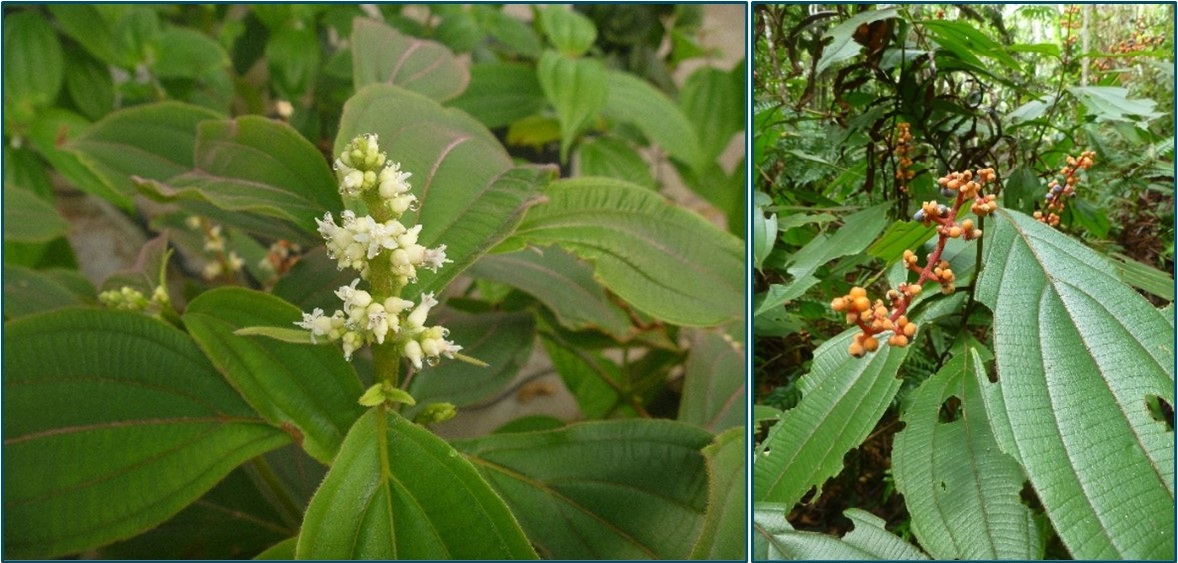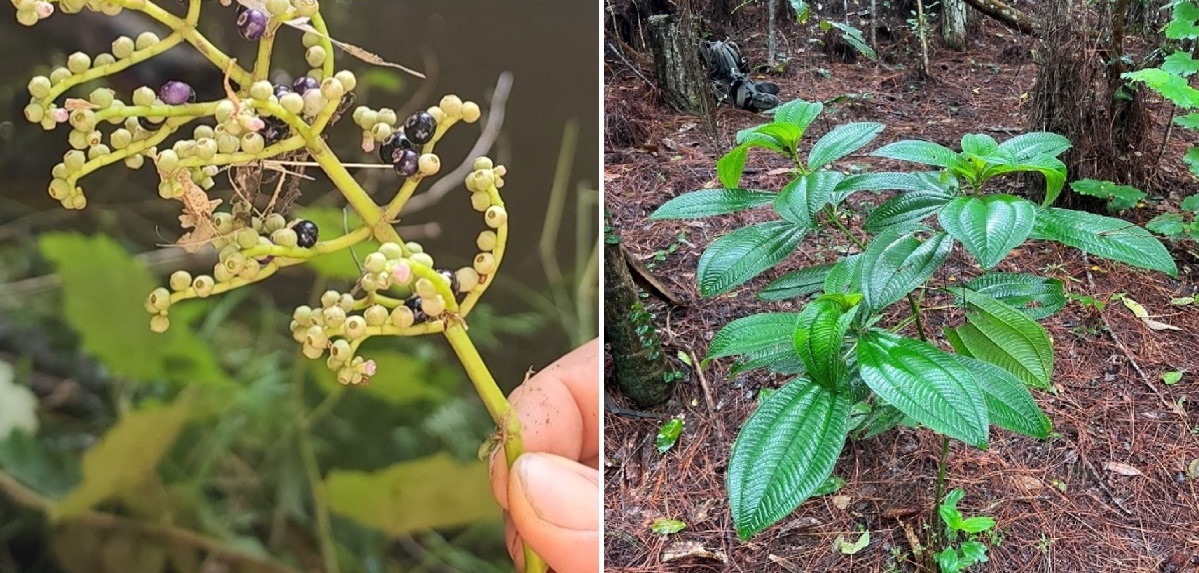Australia is fortunate to be free from many weeds that may harm our primary industries and environment.
All tropical and sub-tropical areas of Australia have climates that suit tropical weeds.
The National Tropical Weeds Eradication Program targets 5 weed species. These species could significantly impact agriculture and the environment in these regions. They could cause irreversible ecological damage to important rainforest regions. This includes the Wet Tropics World Heritage Area in North Queensland and some northern parts of NSW.
Detection in Australia
The 5 species under eradication were detected after 1997.
Limnocharis flava
Limnocharis flava was detected in far north Queensland in 2001.
It’s managed across Local Government Areas (LGAs) in North Queensland, Townsville, areas near Mackay, and South East Queensland. It has also been detected and destroyed in NSW and the Northern Territory.
Miconia species
All Miconia species were declared noxious in Queensland in 1997. Eradication efforts began across the state and in northern parts of NSW from 2008.
Miconia calvescens
Miconia calvescens was detected in 1997. It’s managed across LGAs in North Queensland, with historical records in Southeast Queensland. It’s also being managed across LGAs in northern NSW.
Miconia nervosa
Miconia nervosa was detected in 2004 as an infestation near Mossman.
Miconia racemosa
Miconia racemosa was detected in 2002 near Kuranda.
Mikania micrantha
Mikania micrantha was detected in 1998. It’s being managed across LGAs in North Queensland – around the Hinchinbrook, Cassowary Coast and Mareeba areas.
Response program
The National Tropical Weeds Eradication Program aims to eradicate 5 exotic invasive weed species. They include:
- Limnocharis (Limnocharis flava)
- Miconia (Miconia calvescens, Miconia nervosa, Miconia racemosa)
- Mikania vine (Mikania micrantha).
A small incursion of Miconia calvescens is also under eradication in northern NSW.
The current $25.069 million response plan runs for 4 years from 2024 to 2028. It aims to eradicate the 5 weed species from northern Queensland and NSW. Response activities include:
- surveillance
- restriction of weed spread
- chemical treatment
- destruction and removal of plants.
The response to eradicate these weeds has cost $35.8 million since 2002. Another weed, Miconia crenata (formerly Clidemia hirta), was part of the program until 2015. The detection of a new infested area in 2015 deemed this species no longer technically feasible to eradicate. It’s now managed and controlled as an established weed.
Program governance
The Queensland Department of Primary Industries leads the eradication program.
The program has operated under the national emergency response arrangements since 2002. It’s managed under an arrangement like the National Environmental Biosecurity Response Agreement. Costs are shared by the Australian, state and territory governments.
Research and operational support are provided by stakeholders including:
- Biosecurity Queensland
- Queensland National Parks
- New South Wales Department of Primary Industries and Regional Development
- Local government bodies
- Northern Territory Weeds Management Branch.
See more
How we coordinate a response to an outbreak.
Your obligations
What you must do to limit the spread of exotic weeds.
Report sightings
If you think you have found an exotic weed or an unusual plant, you must report it.
Call the Exotic Plant Pest Hotline on 1800 084 881. Clearly describe what you have seen. You may be told how to collect a sample to help identify the plant.
For signs of exotic pests and diseases in imported goods, sea containers or parcels, call See. Secure. Report on 1800 798 636 or use our online form.
Follow the rules
Keep exotic dangerous pests and diseases out of Australia. Never ignore our strict biosecurity rules.
- Do not move weed seeds on goods, vehicles, clothes or plant material (including soil).
- Be aware of prohibited species when buying plants and seeds (especially online).
- Do not attempt to treat or dispose of suspect exotic invasive weeds yourself.
Import shipments may need to be treated and certified. Before you import, check our Biosecurity Import Conditions system (BICON).
Movement restrictions
There are domestic quarantine restrictions in place. These prevent the spread of exotic weeds. Travellers must not take plants between states and territories.
If you live or travel in northern Queensland or NSW, you must know the laws in place to control the spread of weeds.
Check:
In Queensland there are restrictions on moving plant material, soil and equipment (Business Queensland).
Prohibited plants
- It is a serious offence to introduce, keep or sell plants that are prohibited in Australia. You must not keep, move, give away sell or release these weeds into the environment.
Penalties may apply. - Stay vigilant and informed when buying plants and seeds, especially online.
- See more about prohibited invasive plants (Business Queensland).
About the weeds
Yellow burrhead, Sawah lettuce, Genjer (Limnocharis flava)
Limnocharis (Yellow burrhead, Sawah lettuce, Genjer) is an aquatic herb that grows to a height of up to 1.1m. It restricts water flow and displaces native plants and animals. It provides favourable breeding areas for disease vectors.
The plant has yellow three-petalled flowers. It produces fruit, which contains an average of 1,000 seeds.
Although it is an anchored, emergent aquatic plant, it can grow on wet land in tropical environments.
Flowering can occur throughout the year. It has buoyant fruit and seeds that can disperse and establish in water. Seeds can be carried in mud that sticks to vehicles, machinery, footwear, waterbirds and other animals. Limnocharis has also been detected and removed from backyards where it has been illegally cultivated as a vegetable. This poses a great risk as it can easily spread to waterways.
Seedlings establish frequently in the warm, wet months in far north Queensland (November to May). Seeds longevity can be up to 20 years.
Limnocharis (Yellow burrhead, Sawah lettuce, Genjer) is native to Central and South America. It’s established in parts of Asia and southern USA as an introduced weed.

See more
Find out more about Limnocharis (Business Queensland)
Velvet tree (Miconia calvescens)
Around the world, this plant has been sold under the synonym Miconia magnifia. It’s a small tree, native to tropical America. It stands up to 15m tall, commonly in areas with rainfall over 1800 mm per year.
The leaves have a distinct purple underside. They are 60-70cm long and show 3 veins from the base to the tip. The plant has large branches that produce 300-2,700 small white or pink flowers. The flowers develop into purple or black berries containing 140-230 small seeds. One mature tree can produce 8.9 million seeds per fruiting season. This enables aggressive invasion from just one source plant.
In Australia, flowering occurs mainly between March and October. Fruits are produced 2 months later in trees at least 4 years old. Seeds are dispersed by animals, wind and water. Contaminated soil can be moved on footwear, clothes, machinery or via illegal plant cultivation. The seeds can be viable for more than 15 years. Seedlings can establish in both shaded and forest gap locations.

See more
Miconia (Business Queensland)
Miconia (Miconia nervosa)
Miconia nervosa is native to Central and South America. It can invade rainforest areas and competes with native plants and can impact the habitats of native animals.
This weed can tolerate both shady conditions and vegetation gaps in forests. It can reach heights of up to 3m. Its leaves have 5 distinct veins, with stems covered in small, reddish hairs.
It produces branches of small white flowers that develop into purple-black fruit. Each fruit contains up to 200 seeds. In Australia, flowers and fruit appear year-round. The plants reach reproductive maturity at around 12 months. Seeds are dispersed mainly by birds and can possibly remain viable for 15 years.

See more
Miconia (Business Queensland)
Miconia (Miconia racemosa)
Miconia racemosa is native to central and north-eastern South America. It’s an evergreen shrub that grows to 3m. It colonises in disturbed or degraded sites with rainfall of 1,600-3,000mm.
The leaves show 5 distinct veins with a ‘quilted’ pattern on the leaf surface. The plant produces large branches of small white or pink flowers. They develop into purple or black berries with over 400 small seeds. Seeds are mainly dispersed by birds. The plants are shade tolerant. Field trials suggest buried seeds remain viable after 9 years.
In Australia, the plant flowers and fruits between January and August. This may occur year-round.


See more
Miconia (Business Queensland)
Mile-a-minute, Mikania vine (Mikania micrantha)
Mile-a-minute, or Mikania vine is capable of climbing trees, shrubs and fences. It grows rapidly during monsoonal periods. It smothers and chokes the areas it has colonised.
Mikania vine can be found in a variety of environments in sun or shade. These include damp lowland clearings, swampy or open areas.
Its opposite leaves are heart-shaped and produce white flowers and black fruits during the dry season in north Queensland (May-November).
The vine can produce 40,000 seeds per plant every year. Seeds disperse with wind, animals, water, human activity and vehicles. Buried seed longevity trials have found seeds still viable after 12 years. This makes the vine a real threat to Australia’s world heritage forests, commercial forests, agricultural crops and native animals.
Mikania vine is a serious pest of crops in South and South-east Asia. This includes oil palm, coconut, tea, rubber, banana, citrus, coffee, pineapple, sugarcane and timber species.
The vine is native to the Americas but is also found in West Africa, India, Pacific Islands, South-East Asia and Papua New Guinea.

See more
Mikania vine (Business Queensland)
Resources
See more about the response program or other invasive weeds:
- Biosecurity program for prevention and control of tropical weeds (Qld DAF)
- National Tropical Weeds Eradication Program
- Miconia species – NSW Weedwise (NSW Department of Primary Industries)
- Restricted, prohibited and other invasive plants (business.qld.gov.au)
- Weed identification tool (weeds.brisbane.qld.gov.au)
- Weeds Profiles (weeds.org.au)
- Government weed strategies and lists (Weeds Australia)
- Australian Weeds Strategy 2017-2027 (agriculture.gov.au)